Text: Peter Tepe | Section: Art-Related Science
Summary: The first example of art-related science emerged over 25 years ago: Peter Tepe introduced his lecture Mythisches, Allzumythisches (The Mythical, the All-Too-Mythical), which took place in the 1993/94 winter semester in collaboration with Helge May – probably the first-ever lecture to be held in theatrical form. This article explores the science/art connections at play here.
Note from the editors
Art-related science refers to those scientists who draw on artistic concepts/methods/results in their teaching, research or specialist publications. Like science-related art, its practice establishes a specific connection between science and art which requires closer examination. The article Art-Related Science – a new section in w/k, published on 27 April 2019 in the German part of w/k and on 28 February 2022 in the English part, explains the concept in more depth. Over time, the new section aims to document and analyse as many individual variants of this science/art connection as possible. The following article comes under subsection 4a: Articles by Art-Related Scientists.
Theatrical lecture
The theatrical lecture (Vorlesungstheater) took place in the 1993/94 winter semester within the framework of the interdisciplinary research topic titled Myth, Ideology and Methods (Mythos, Ideologie und Methoden) which I initiated in 1987. To ascertain whether there has been anything like it before or since would require research. Comprehensive documentation of the lecture is available in the publication: Peter Tepe/Helge May: Mythisches, Allzumythisches. Theater um alte und neue Mythen 1 (The Mythical, the All-Too-Mythical. Theatre around old and new myths 1). Ratingen 1995.

In the context of the large-scale academic reform of the 1990s, many attempts were made in the department of German Studies at the Heinrich-Heine-Universität Düsseldorf to test new forms of teaching and learning, and to inform an interested public of the results. I experimented primarily with alternative forms of lecturing. My concern was not to abolish the standard lecture format, in which a lecturer typically holds a lengthy talk – be it with or without the use of media, with or without discussion. Rather, I was interested in trying out new forms of lecture so as to broaden the spectrum of possibilities and thereby counteract the prevailing monoculture.
From the outset, the lecture in theatrical form was not intended as a model to be applied in everyday university life, but rather as a one-off scientific/artistic intervention that would last just a single semester. Together with the team – which, alongside Helge May, included Sabine Jambon, Yoshiro Nakamura, Susanne Stemmler and Ingo Toben – I adhered to the motto: “run a highly unusual university course just once in your life, even if it requires immense effort and is totally weird.”
The Epilogue on the backstory (pp. 293–296 in the book) outlines the genesis of the project.
“How it all began? Well, ever since the beginning of the ’90s I have been fascinated by the idea of giving lectures in dialogue form. But using a theatrical or even a cabaret format never crossed my mind. My rather vague starting point was ‘to somehow tie into the long tradition of philosophical dialogues that started with Plato’, whereby the figure I had in mind was not Plato but Hume, whose Dialogues Concerning Natural Religion had captivated me in my forays into the history of the theory of ideology [1].
It was also clear to me that I could not train myself to become an experienced dialogue writer in such short time, hence my initial plan to collaborate with an expert in dialogue. Since I didn’t know anyone who fit the brief, the original idea had to be put on hold – but it was never abandoned. From the 1993/94 winter semester onwards, I wanted to use various lectures to summarise the current state of my thinking on myth and was convinced that, as subject matter, myth would be a perfect candidate for my experiment with a dialogue-based lecture.
Helge May visited the seminar Heinrich Heine as ‘mythologist’– organised by Markus Küppers and myself – in the winter semester of 1992/93; but I’d already heard of him before this. I had visited his children’s musical Die Pappnasenbande, which ran for several months in the theatre on Luegallee, and I recall being just as excited by it as my little son Mauritz. However, only after his impressive lecture on Heine and Wagner’s Tannhäuser did it occur to me that he was – or might be – exactly the person I was looking for. Everything fell into place: I had found an experienced playwright[2] and actor who even showed some interest in ‘mythological’ themes. In short, I contacted him, told him about my idea for a ‘dialogical lecture on myths’ and asked him if he would be interested in collaborating. After brief consideration, he agreed. Thus our collaboration began.[3]
An equal division of labour in our collaborative work was extremely important to me from the very beginning. I was responsible for the ‘mythological’ knowledge and had the final say in all issues concerning thematic content. Helge May, on the other hand, was responsible for the dialogues and their enactment: he had the final say in all things to do with the theatrical setting. This form of collaboration brought about productive tensions and engaging dissonance, which would never have happened had I hired Helge May simply as a kind of ghostwriter and awarded myself overriding control of the project.
We began by looking for a narrative framework as a vehicle for ‘mythological’ knowledge. This narrative framework was not only intended to open up a panoply of theatrical variations to play with, but also to generate internal references to the topic of myth. My initial idea was as follows (I quote from the first draft): two rats live in a cave. A catastrophe, which may remain undefined, forces two other animals, a toad and a worm, to seek shelter with the rats – at least for the winter, but probably also for the summer. Leaving the cave would mean risking their lives, so they are forced to accept the rats’ conditions. In exchange for food and accommodation the rats demand two things:
● Entertainment (the worm is mainly responsible for this), i.e. comic interludes, possibly songs, alleviating the general routine.
● Information on mythology and research into mythology (for which the toad is responsible).
For the sake of performative clarity Helge May insisted on replacing the worm with a hedgehog. He promptly delivered a draft of the hedgehog’s frame story which we incorporated almost unaltered into the first lecture.
We immediately agreed on having the actors perform in everyday clothes, but wearing animal masks. The ‘stage design’ was to be as simple as possible and, to avoid disrupting the university’s teaching schedule, easy to set up and dismantle. A suitable photo of a cave was to be projected onto the auditorium wall. Each lecture would include a ten minute interval. The illusion was never to be broken by the usual lecture discussions (although we sought to create new means of intervention by having students fill out slips of paper during the break). Artists were to be invited for guest appearances. The theatrical lecture was to be documented on video, if possible by media students. Since we realised that our theatre would only work if played to a large audience we had to ensure enough publicity (leaflets, posters, ads in local newspapers, contact with the press).
And the team? Well, finding suitable actors who were willing to work without professional pay turned out to be less difficult than one might assume. In the field of mythology research, several people already had theatre experience. I offered the roles of the two rats to Sabine Jambon and Ingo Toben – fortunately, both accepted immediately. Obviously, Helge May had to play the hedgehog, which left me – as the only person with no acting experience – with the role of the toad.
My colleague Yoshiro Nakamura agreed to take on the technical tasks (lighting, projection, sound system etc.); a little later he was joined by Susanne Stemmler. Claudia Lemmer made the masks, and Minou Friele and Nele Pricken were responsible for the video recordings.
After several lecture-performances, Helge May proceeded to give acting duties also to Susanne Stemmler and Yoshiro Nakamura (no one could die as gloriously as him). Yoshiro even went on to write all of the rat myths, which Helge then integrated into the dialogues.
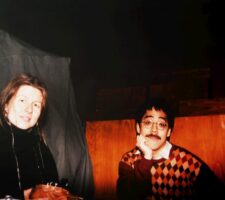


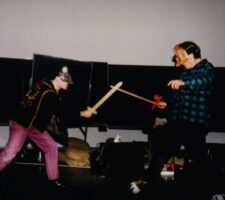
For a whole semester the team worked together in a dedicated, productive and harmonious way. An absolutely unique experience in my many years at the university … The theatrical lecture was conceived as a dovetailing of science and art, which was reinforced when, for five of the ‘lectures’, we invited artists as guests whose appearances were integrated into the storyline. A singer (Nele Pricken) gave the first performance, followed by a saxophonist (Elmar Krick). Then came a sound installation performed by Chris Scholl and a surprise appearance by guest actor Olaf Reichstein. Two musicians, Mischa Esch and Detlef Heidkamp, brought the evening to a close.
I have often been asked whether the theatrical form interfered with the academic content. My usual response consists of two points.
1. I could, and would, also use the mythological parts of the text in a normal lecture. The theoretical content has to be kept concise and focused, which does not mean that it has been compromised for entertainment purposes.
2. On the other hand, it is clear that our approach pays close attention to the acting scenes, the songs, the performances of the guest artists etc., and that the lecture-like scenes suffer somewhat as a result. But we must bear in mind that our theatrical lecture – or Mythological Cabaret, as Helge May calls it –is not intended as a model for everyday university life. Rather, it is a university festival in 14 stages. Surely the aforementioned disadvantages can be accepted for such a scientific/artistic festival, which in this form will perhaps remain unique.
The experiment will of course have an influence on my usual lecture routine (and hopefully not just on mine). Indeed, due to its high maintenance (rehearsals every Sunday into the night, not to mention other things) the theatrical lecture is not a sustainable format – but hybrid forms are perfectly feasible. An example of this would be: Mythisches, Allzumythisches II in the 1994 summer semester. Together with the original team, Helge May will conceive two such ‘lectures’ in the tried and tested way, while for the remaining ‘lectures’ I will write non-theatrical thematic dialogues to be ‘performed’ with changing partners.
Düsseldorf, February 1994 Peter Tepe”
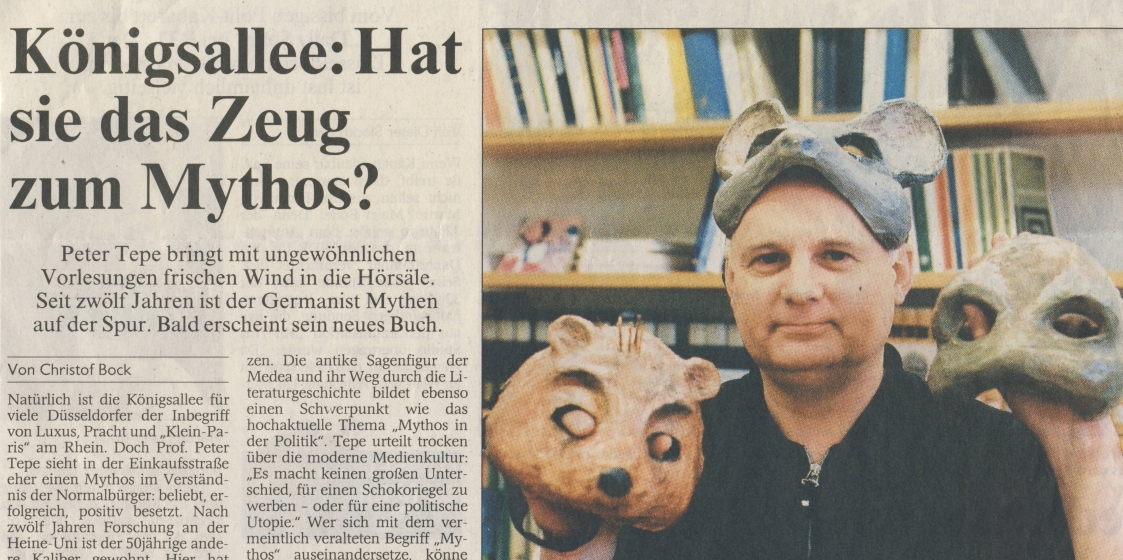
It was indeed a university festival in 14 stages rather than a model for everyday university life, although some elements could certainly be integrated into regular teaching practice. The theatrical lecture sparked great interest in the media – even beyond Düsseldorf. This led to a television appearance on the programme Happy Hour in the Schaufenster Düsseldorf (WDR, 4 February 1994, with an interview and excerpt from a lecture) as well as the production of a sketch with the WDR team (appearance on Bunt TV in Aktuelle Stunde, 19 February 1994). In the press review you will find all published articles I am aware of.
Even in its conception, the lecture was devised as a team production. Helge May’s part in executing the concept is particularly noteworthy: first of all, he incorporated my mythological texts into his fictional dialogues. He was also the one who came up with all the scenic ideas, songs, etc. Furthermore, he was in charge of directing and, of course, took on an acting role. Together, the whole team put on an unforgettable performance. Incidentally, a project like this would be unimaginable in today’s university system.
The significance of the theatrical lecture has not always been fully acknowledged. Seeking to redress a widespread misunderstanding, the following passage was added in the brochure The Study of Research (Das Lernen der Forschung)[4], which was distributed in the university in 1998:
“Anyone being told about the – admittedly rather absurd – project of staging a lecture in theatrical form is likely to assume that academic standards are being sacrificed for the sake of entertainment. This may prompt the suspicion or preconception that the project is a dubious and academically somewhat shaky endeavour.
Neither prejudice stands up to closer scrutiny. For the theatrical lecture Mythisches, Allzumythisches, Helge May – as is also evident in the book version – successfully devised a theatrical form with high entertainment value; yet upon closer inspection, there is no sign of academic or philosophical content being sacrificed or even diluted. Peter Tepe’s academic texts are simply embedded in a witty and varied narrative framework. Besides, this extraordinary lecture was understood and conceived from the very outset as a one-off scientific/artistic experiment, and certainly not as a stepping-stone towards ‘entertainment’. The theatrical lecture can be seen as a specific variant of an interdisciplinary approach, both in terms of content and as a form of communication. So those who accuse the whole project of being a dubious affair need to provide some other justification than simply pointing out that, yes, lectures are already taking place in theatrical form.”
The lecture Mythisches, Allzumythisches II (1994 summer semester) mentioned above also gave rise to a book: Peter Tepe/Helge May, Mythisches, Allzumythisches II. Abenteuer um alte und neue Mythen. (The Mythical, the All-Too Mythical II. Adventures around old and new myths) Ratingen, 1996.
Volume II also includes an Epilogue on the backstory (pp. 340–342) and discusses the relevant connections.
In the 1990s, I experimented further with alternative lecture formats: one of these was to present a lecture as a forum for debate (with Rudolf Heinz) that was held once; another variant was a dialogical lecture that was held five times – sometimes also including guest artists. More detailed information on this can be found in chapter 15 of the following essay published in Mythos-Magazin (www.mythos-magazin.de), which presents the entire history of this specialised development:
▷ Peter Tepe: 25 Jahre Schwerpunkt Mythos, Ideologie und Methoden… und kein Ende, available online at http://www.mythos-magazin.de/geschichtedesschwerpunkts/pt_25Jahre.pdf
▷ Peter Tepe: 25 Jahre Schwerpunkt Mythos, Ideologie und Methoden… und kein Ende – Dokumentation 1,available online at http://www.mythos-magazin.de/geschichtedesschwerpunkts/pt_25Jahre-Dokumentation1.pdf
Image above the text: From the lecture (1993/94). Sabine Jambon (left), Ingo Toben (right). Photo: Susanne Stemmler.
[1] This is also the title of part II of my publication, Theorie der Illusionen (Essen, 1988).
[2] Zipp Zapp Zauberbohnen (1991), Die Pappnasenbande (1992), Die Blaublabben kommen! (1993).
[3] The official title of the lecture was: Mythisches, Allzumythisches. Dialoge zur Einführung in die Mythologie.
[4] The following text was published some years later: P. Tepe/Y. Nakamura/B. zur Nieden: Das Lernen der Forschung. Der interdisziplinäre Schwerpunkt Mythos/Ideologie. In: U. Welbers/M. Preuss (eds.): Die reformierte Germanistik. Dokumentation zur Düsseldorfer Studienreform, Düsseldorf, 2000, pp. 213–237. For the quote: p. 228.
Translated by Rebecca Grundmann.
How to cite this article
Peter Tepe (2022): Vorlesungstheater. w/k–Between Science & Art Journal. https://doi.org/10.55597/e7190

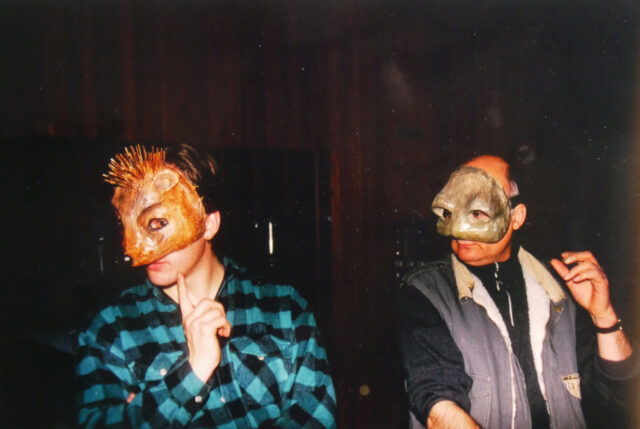
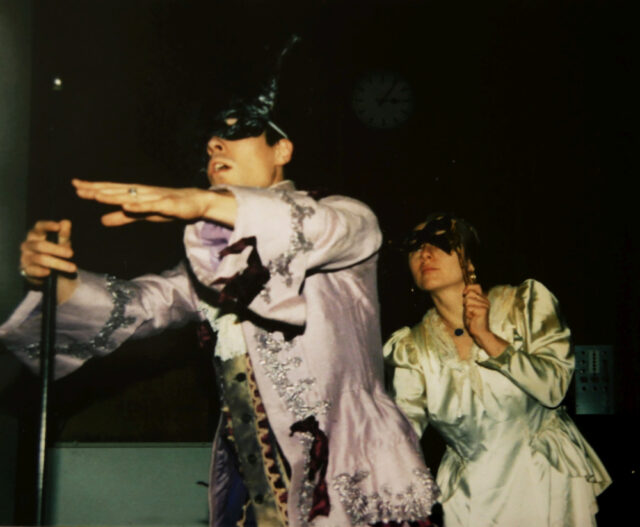
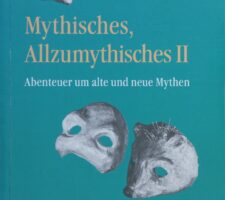

Be First to Comment